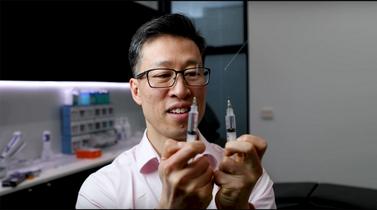Dermal fillers: Why I use cannulas and not needles!
With non-surgical anti-ageing treatments, including anti-wrinkle injections and dermal filler treatments becoming more popular you probably know that needles are used to perform these procedures. But one thing that’s not spoken about openly is the best way to inject dermal filler treatments. Dr Gavin Chan (MBBS, Cosmetic Doctor, Liposuctionist) and his team of Cosmetic Doctors and Cosmetic Nurses don’t use needles when treating patients with dermal filler – they use cannulas.
Dr Gavin Chan explains, “The most important tool I’ve used over my 15 years of injecting dermal fillers is a cannula. I first started injecting dermal fillers using needles. Way back then, there wasn’t any other option. The boxes of dermal fillers had small needles inside that the dermal filler companies instructed us to use.” Using small needles to inject dermal filler means many insertion points are needed. This can result in swelling and bruising.
Questioning this method of dermal filler injection, Dr Gavin Chan decided to stop using needles to inject dermal filler and started to use cannulas. With a rounded, blunt tip, cannulas have some huge advantages over needles for dermal filler treatment. Interestingly facial fat transfers, which have been performed for an even longer time than dermal fillers, have only been performed using cannulas. For some reason though, when dermal fillers were developed some companies only wanted it injected using the needles they provided.
Cannula Vs Needle when injecting dermal filler. What are the differences?
One of the main key advantages of a using a cannula over a needle is that it’s blunt. Cannula’s can’t penetrate the skin like a needle and are unable to penetrate a vein or artery very easily. When you have dermal filler treatment with a cannula, a small needle is used to create an entry point for the cannula. This point is used to pass the cannula to areas beneath your skin and can be re-entered multiple times during the dermal filler procedure. This reduces the incidence of bruising and swelling occurring.
Using blunt cannulas for dermal filler treatments instead of needles can reduce the likelihood of dermal filler being injected into the artery that feeds the retina or the back of the eye. Dr Gavin Chan explains, “if this happens, you can lose vision in that eye. I’m not saying it’s impossible to inject into a blood vessel, vein or artery with a cannula, but because it’s blunt it’s much less likely to penetrate into that vein or artery.”
The second advantage of using cannulas for dermal filler treatments is its longer length. When dermal filler is injected into various parts of the face with a very short needle, the patient will need multiple injections. When Cosmetic Practitioners use a cannula, they go in from one injection point to reach many points under the skin. This is particularly important when dermal filler is used to treat the lips. If short needles are used to inject dermal filler in the lips, multiple injections will be needed. This usually results in swelling and bruising occurring.
The third advantage of a using a cannula for dermal filler treatments is that Cosmetic Practitioners can feel where the dermal filler treatment is being placed. This is particularly important when injecting dermal fillers around the eye area. Dr Gavin Chan explains, “When using a cannula to treat tear troughs I know whether I am in the lower eye near the orbicularis retaining ligament which sits like a hammock just under the eye. This ligament differentiates the upper cheek from the lower eyelid. If I want to inject dermal filler into the lower eyelid, I know I need to go through this ligament with a cannula. If I was to use a needle, there’s no precise way to know if I’m injecting in the correct position.” Cosmetic Practitioners who use cannula’s for dermal filler treatments tend to develop a ‘feel’ for the injection process. This can make the injection process longer, but it’s a more accurate advanced injection technique.
How do Cosmetic Practitioners choose which size cannula to use?
When choosing which size cannula to use for injecting dermal fillers, Cosmetic Practitioners have a few factors to consider. The first factor is the gauge (the thickness and diameter) of the cannula. The greater the gauge, the finer the needle will be. Dr Gavin Chan notes, “A few years ago, a thick volumizing dermal filler was released onto the market with an 18-gauge cannula to inject with. When we first used this cannula, we had to use a lot of local anaesthetic in the face before we could start the injection process. We also discovered that using an 18-gauge cannula can also be quite painful for our patients. This large gauge cannula also resulted in patient’s faces swelling.” After this experience, Dr Gavin Chan and his team of Cosmetic Doctors and Cosmetic Nurses started to use a 25-gauge cannula. This is 2.5 times finer than an 18-gauge cannula and closely resembles thin needles.
Cosmetic Practitioners also need to consider the flow characteristics of the cannula they choose. A larger cannula will flow a lot quicker than a smaller cannula. When a Cosmetic Practitioner uses a finer cannula, the dermal filler injections are slower and less likely to inject a vein or artery. Dr Gavin Chan now prefers to use a 27-gauge cannula for dermal filler treatments explaining, “it’s less traumatic, there’s less swelling to the patient and less pain. If a 27-gauge cannula accidentally perforated an artery, the rate of dermal filler flow would probably be not great enough to overcome the rate of flow of blood in the in the artery.” Using a 27-gauge cannula can also help reduce the likelihood of injecting into an artery and causing complications such as blindness.
Where to get the best dermal filler treatment in Melbourne
With more clinics offering cut-price dermal filler treatment, Dr Gavin Chan suggests you ask the following questions before booking a dermal filler appointment:
- What experience and training do the Cosmetic Practitioners have?
- What pain minimisation techniques does the medical clinic use?
- Does the clinic have up to date before and after photos of their patients?
- Is the medical clinic reputable with a team of highly trained and experienced Cosmetic Doctors and Cosmetic Nurses who perform dermal filler treatment?
- If you don’t like the dermal filler treatment result, do the Cosmetic Practitioners how to dissolve the dermal fillers?
Call our friendly customer service team to book a dermal filler consultation today 1300 863 824.

